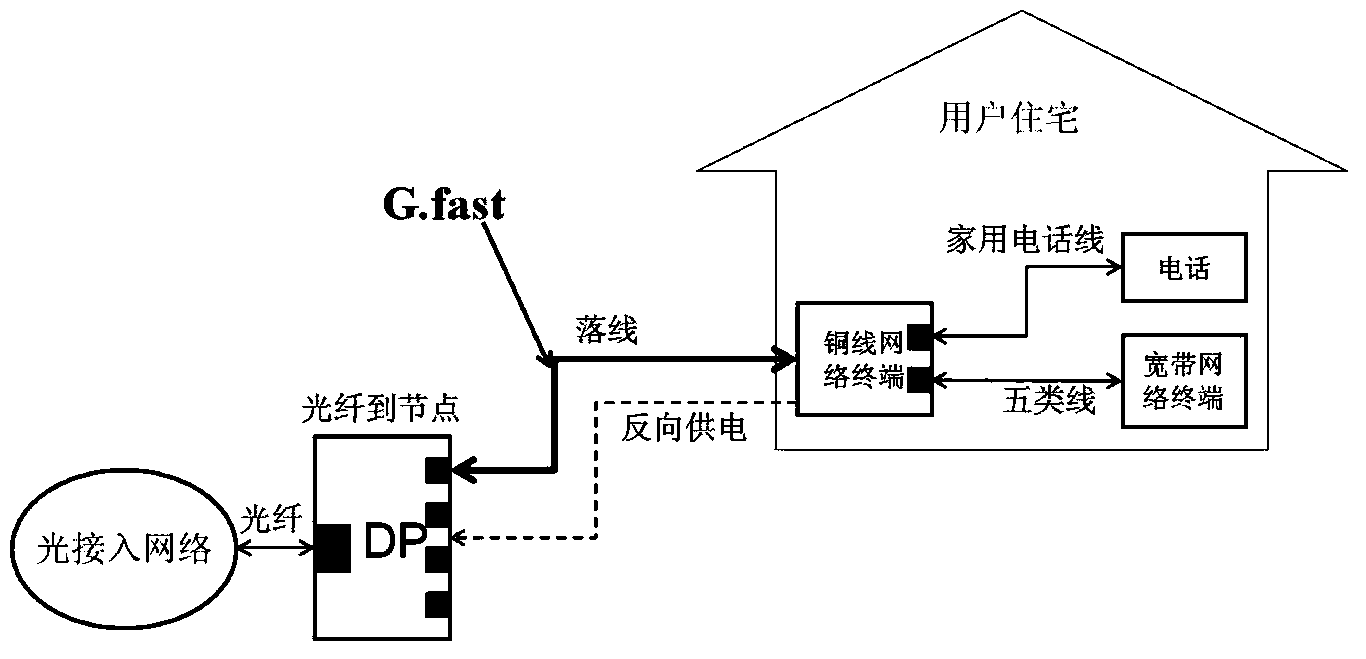Energy saving method and device
A technology for sleep, central office equipment, applied in the field of communication, can solve the problems of reducing the overall power consumption of the system, not providing, etc., to achieve the effect of reducing the overall power consumption, fast line environment changes, and fast adaptation
- Summary
- Abstract
- Description
- Claims
- Application Information
AI Technical Summary
Problems solved by technology
Method used
Image
Examples
example 1
[0072] This embodiment adopts the method of gradually doubling the sleep period to save energy. Here, please also refer to image 3 , image 3 It is a schematic diagram of realizing the gradual doubling of the sleep period according to the preferred embodiment of the present invention. The G.fast system of the node device and the user terminal mainly operates according to the following steps during the sleep mode process:
[0073] Step 1: There is no data transmission on the link between the user terminal and the corresponding interface of the node device, and the two enter an idle state.
[0074] Step 2: When the duration of the link idle state reaches the system setting value Tidle, the user terminal sends a sleep request message SS (Sleep Select) to the corresponding port of the node device, which contains the following information: the initial duration of the sleep period Tsync, the method of adjusting the time of the sleep period : Multiplication step by step, the multip...
example 2
[0080] This embodiment adopts the method of dynamically adjusting the sleep period to save energy, which mainly includes the following steps:
[0081] Step 1: There is no data transmission on the link between the user terminal and the corresponding interface of the node device, and the two enter an idle state.
[0082] Step 2: When the duration of the link idle state reaches the system setting value Tidle, the user terminal sends a sleep request message SS (Sleep Select) to the corresponding port of the node device, which contains the following information: the initial time length of the sleep period Tsync, the maximum and minimum time length Tsleep_max and Tsleep_min, and the adjustment method (determined by different algorithms), the time Tretrain of the channel retraining operation, etc.
[0083] Step 3: After receiving the message SS, the node device sends an acknowledgment message ACK to the user terminal. Afterwards, the node device and the user terminal enter the sleep...
example 3
[0087] This embodiment adopts the method of negotiating the next sleep during the wake-up period to save energy, which mainly includes the following steps:
[0088] Step 1: There is no data transmission on the link between the user terminal and the corresponding interface of the node device, and the two enter an idle state.
[0089] Step 2: When the duration of the link idle state reaches the system setting value Tidle, the user terminal sends a sleep request message SS (Sleep Select) to the corresponding port of the node device, which contains the following information: the length of the sleep period Tsleep, the operation mode of the wake-up period (time recovery and synchronization or channel retraining), etc.
[0090] Step 3: After receiving the message SS, the node device sends an acknowledgment message ACK to the user terminal.
[0091] Then the node device and the user terminal enter the sleep mode.
[0092] Step 4: The system sleeps according to the time determined in...
PUM
 Login to View More
Login to View More Abstract
Description
Claims
Application Information
 Login to View More
Login to View More - R&D
- Intellectual Property
- Life Sciences
- Materials
- Tech Scout
- Unparalleled Data Quality
- Higher Quality Content
- 60% Fewer Hallucinations
Browse by: Latest US Patents, China's latest patents, Technical Efficacy Thesaurus, Application Domain, Technology Topic, Popular Technical Reports.
© 2025 PatSnap. All rights reserved.Legal|Privacy policy|Modern Slavery Act Transparency Statement|Sitemap|About US| Contact US: help@patsnap.com



